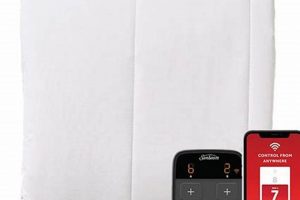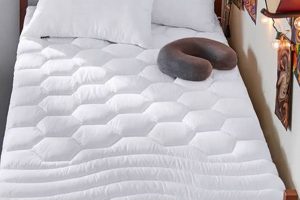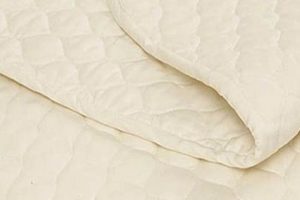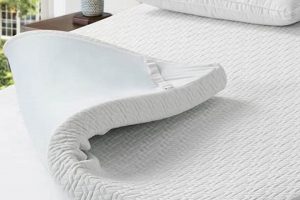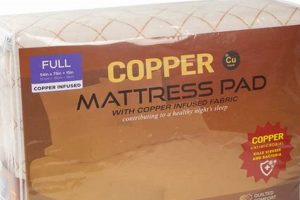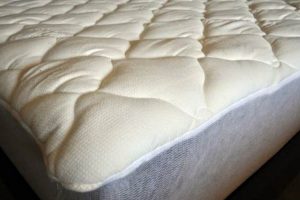A bedding accessory designed to enhance comfort and protect a queen-sized mattress, constructed from certified organic materials, serves as a barrier against spills, stains, and wear. These materials commonly include organic cotton, wool, or bamboo, cultivated without synthetic pesticides or fertilizers. For example, a consumer might select such a pad to prolong the lifespan of their mattress while minimizing exposure to potentially harmful chemicals.
The significance of choosing organically produced mattress protectors lies in their potential health and environmental advantages. Organic textiles are often associated with reduced allergic reactions and skin sensitivities, particularly beneficial for individuals with sensitivities. Furthermore, the cultivation of organic materials supports sustainable agricultural practices, minimizing environmental impact by avoiding the use of harmful chemicals that can contaminate soil and water resources. Historically, the demand for such products has grown alongside increasing awareness of environmental and health concerns related to conventional textile production.
The following sections will delve into specific aspects of these mattress protectors, including a comparison of different organic materials, considerations for selecting the appropriate type for individual needs, and guidelines for proper care and maintenance to ensure longevity and continued benefits.
Essential Considerations
Proper selection and maintenance of a bedding protector crafted from organic materials designed for queen-sized mattresses ensures optimal performance and longevity. The following tips offer guidance on making informed decisions and maximizing the product’s benefits.
Tip 1: Material Verification. Prior to purchase, confirm the presence of legitimate organic certification, such as GOTS (Global Organic Textile Standard). Such certifications guarantee that the product adheres to strict environmental and social criteria throughout the entire supply chain.
Tip 2: Thickness Evaluation. Assess the thickness of the protector in relation to desired comfort and mattress protection. A thicker pad offers enhanced cushioning and greater defense against spills, but may alter the feel of the mattress.
Tip 3: Waterproofing Examination. If waterproofing is a requirement, scrutinize the type of waterproof barrier employed. Opt for materials like TPU (thermoplastic polyurethane) that are free from PVC (polyvinyl chloride) and phthalates to minimize exposure to potentially harmful chemicals.
Tip 4: Breathability Assessment. Evaluate the breathability of the protector to prevent heat buildup and promote comfortable sleep. Natural fibers like organic cotton and wool generally exhibit superior breathability compared to synthetic alternatives.
Tip 5: Proper Fit Confirmation. Ensure the selected protector is specifically designed for queen-sized mattresses and features deep pockets to accommodate varying mattress depths. A secure and snug fit is essential for preventing slippage and maintaining consistent protection.
Tip 6: Laundering Adherence. Follow manufacturer-specified laundering instructions carefully. Avoid harsh detergents, bleach, and high heat, as these can degrade the organic fibers and compromise the protector’s integrity.
Tip 7: Stain Management. Address spills and stains promptly. Gently blot the affected area with a clean cloth and mild detergent solution. Avoid vigorous rubbing, which can damage the fabric.
Adhering to these guidelines facilitates the informed selection and responsible care of a quality mattress protector, promoting a healthier sleep environment and extending the lifespan of the underlying mattress.
The subsequent sections will elaborate on specific cleaning and care techniques, as well as address common concerns related to the use of these protective bedding items.
1. Organic material certification
Organic material certification provides assurance that a mattress pad labeled as “organic” adheres to specific, verifiable standards regarding the cultivation, processing, and manufacturing of its constituent materials. This certification is crucial for consumers seeking products free from synthetic pesticides, herbicides, and other potentially harmful chemicals commonly used in conventional textile production. In the context of a “organic mattress pad queen,” the certification serves as a critical indicator of the product’s authenticity and environmental integrity.
- GOTS (Global Organic Textile Standard) Compliance
GOTS certification represents a globally recognized standard for organic textiles. It verifies that the entire supply chain, from raw material sourcing to manufacturing, meets rigorous environmental and social criteria. For a mattress pad, GOTS certification ensures that the organic cotton or wool used is grown without harmful chemicals, processed with minimal environmental impact, and produced under fair labor conditions. The presence of a GOTS label on a “organic mattress pad queen” offers consumers a high degree of confidence in the product’s organic status.
- OEKO-TEX Standard 100 Certification
While not exclusively organic, OEKO-TEX Standard 100 certification tests for harmful substances in textile products. It verifies that the finished mattress pad, including all components, is free from levels of potentially toxic substances known to be harmful to human health. While it doesn’t guarantee organic origin, it complements organic certifications by providing an additional layer of assurance regarding chemical safety.
- USDA Organic Certification
In some cases, components of a mattress pad, such as the cotton or wool fill, may be certified under USDA organic standards. This certification primarily focuses on agricultural practices, ensuring that the raw materials are grown in accordance with USDA organic regulations, which prohibit the use of synthetic pesticides, herbicides, and genetically modified organisms. A “organic mattress pad queen” featuring USDA-certified components demonstrates adherence to stringent agricultural standards.
- Third-Party Verification Bodies
Reputable third-party organizations conduct audits and inspections to verify compliance with organic standards. These independent verification bodies ensure that manufacturers are accurately representing their products as organic and that they are adhering to the required practices throughout the supply chain. Their involvement enhances the credibility of the organic certification process for a “organic mattress pad queen,” providing consumers with independent confirmation of its organic status.
The various forms of organic material certification collectively contribute to the overall integrity of a “organic mattress pad queen.” Consumers relying on these certifications can be more confident in the product’s adherence to organic standards, promoting a healthier sleep environment and supporting sustainable manufacturing practices. Without such
verification, claims of organic composition remain unsubstantiated and potentially misleading.
2. Queen mattress dimensions
Accurate queen mattress dimensions represent a foundational requirement for the effective utilization of an “organic mattress pad queen.” A queen-sized mattress typically measures 60 inches in width and 80 inches in length. The congruence between these dimensions and the pad’s size is not merely a matter of fit but directly impacts the pad’s intended function. A pad that is too small will fail to provide adequate coverage, leaving portions of the mattress vulnerable to spills, stains, and general wear. Conversely, a pad that is excessively large may bunch, shift, or create discomfort for the sleeper.
The dimensional compatibility directly influences the protective capacity and overall performance of the pad. For instance, if a queen mattress deviates slightly from the standard dimensions, perhaps due to manufacturing tolerances, the choice of pad must account for these variations to ensure complete coverage. A real-life example involves mattresses with pillow tops or deep profiles, which necessitate pads with deeper pockets and elasticized edges to accommodate the increased depth. Failure to consider these nuances can result in a poorly fitted pad that compromises its protective function and contributes to premature wear.
In summary, the dimensional relationship between a queen mattress and its corresponding “organic mattress pad queen” represents a critical determinant of functionality. Precise adherence to standard measurements, coupled with considerations for mattress-specific variations, is essential for optimal mattress protection, enhanced sleep comfort, and prolonged product lifespan. Neglecting this fundamental aspect undermines the intended benefits of the pad and diminishes its overall value proposition.
3. Hypoallergenic properties
The connection between hypoallergenic properties and an organic mattress pad designed for queen-sized mattresses is a significant consideration for individuals prone to allergies or sensitivities. The primary cause of this connection lies in the materials utilized in the construction of the pad. Conventional mattress pads often incorporate synthetic materials and chemical treatments that can release volatile organic compounds (VOCs) and other allergens, triggering reactions in susceptible individuals. Conversely, an “organic mattress pad queen” is typically crafted from materials such as organic cotton, wool, or bamboo, cultivated and processed without synthetic pesticides, dyes, or formaldehyde. These natural materials are inherently less likely to provoke allergic responses.
The importance of hypoallergenic properties as a component of an “organic mattress pad queen” extends beyond mere comfort; it is a matter of health. For example, individuals with asthma, eczema, or chemical sensitivities may experience exacerbated symptoms when exposed to conventional bedding materials. By selecting an organic pad with hypoallergenic properties, they can minimize their exposure to potential irritants and create a more conducive sleep environment. Furthermore, the breathability of natural materials, such as organic cotton, contributes to a reduction in moisture buildup, which can inhibit the growth of dust mites and mold, common allergens that thrive in warm, humid environments. This aspect is particularly relevant in humid climates or for individuals who perspire heavily during sleep.
In summary, the hypoallergenic properties inherent in an “organic mattress pad queen” offer a tangible benefit to allergy sufferers and health-conscious consumers. By mitigating exposure to synthetic chemicals and allergens, these pads can contribute to improved sleep quality and overall well-being. While challenges remain in ensuring complete allergen avoidance, the use of certified organic materials represents a significant step towards creating a healthier and more comfortable sleep surface. This understanding underscores the practical significance of considering material composition when selecting bedding products, particularly for those with sensitivities or allergies.
4. Washability and care
The maintenance requirements of an “organic mattress pad queen” represent a critical factor in preserving its integrity and extending its useful lifespan. Washability, in particular, is paramount given the pad’s function as a protective barrier against spills, stains, and allergens. Proper care protocols not only maintain hygiene but also safeguard the organic materials from degradation.
- Laundering Frequency and Impact
The frequency of laundering significantly influences the longevity of an organic mattress pad. While regular washing removes accumulated dust mites, sweat, and other allergens, excessive washing can degrade the organic fibers, reducing their protective qualities. For example, a pad used in a guest room might require less frequent washing compared to one used nightly by an individual with allergies. The impact of laundering frequency necessitates a balanced approach, adhering to manufacturer guidelines while considering individual usage patterns.
- Detergent Selection and Fiber Preservation
The choice of detergent directly affects the preservation of the organic materials. Harsh chemicals and bleaching agents found in conventional detergents can strip natural fibers, compromising their hypoallergenic properties and reducing their overall durability. Opting for mild, eco-friendly detergents specifically designed for organic fabrics minimizes the risk of damage and ensures the pad retains its beneficial qualities. A real-world example involves selecting a detergent free from optical brighteners to prevent discoloration and maintain the natural color of the organic cotton.
- Drying Methods and Material Integrity
The method of drying significantly impacts the material integrity of an “organic mattress pad queen.” High heat settings in conventional dryers can cause shrinkage, warping, and fiber damage. Air drying or using a low-heat setting is generally recommended to preserve the pad’s shape and texture. For instance, hanging the pad outdoors on a breezy day allows for natural drying without exposing the fibers to excessive heat. This practice helps maintain the pad’s structural integrity and extends its lifespan.
- Stain Treatment and Fabric Protection
Effective stain treatment is crucial for maintaining the appearance and hygiene of an organic mattress pad. Promptly addressing spills with gentle, natural stain removers prevents stains from setting and becoming difficult to remove. Avoid using harsh chemicals or vigorous scrubbing, as these can damage the delicate organic fibers. A practical example includes blotting a spill with a mixture of water and vinegar to neutralize the stain without compromising the fabric’s integrity. Proper stain treatment protects the fabric and preserves its appearance.
These facets underscore the importance of adhering to appropriate washability and care protocols for an “organic mattress pad queen.” By selecting gentle detergents, employing low-heat drying m
ethods, and addressing stains promptly, consumers can prolong the pad’s lifespan, maintain its hypoallergenic properties, and ensure a clean and healthy sleep environment. Neglecting these considerations can lead to premature degradation and diminished functionality, undermining the investment in an organic product.
5. Mattress protection level
The relationship between mattress protection level and an organic mattress pad designed for a queen-sized bed (“organic mattress pad queen”) is characterized by a direct correlation: the primary function of such a pad is to safeguard the underlying mattress from various potential hazards. The cause-and-effect relationship is evident the presence of the pad mitigates the impact of spills, stains, allergens, and physical wear on the mattress itself. The level of protection offered becomes a critical determinant of the pad’s overall effectiveness and value. For example, a pad with a robust waterproof barrier will effectively prevent liquid penetration, thereby preserving the mattress’s integrity and preventing mold or mildew growth. The absence of such a barrier significantly reduces the protection level, rendering the mattress vulnerable to damage. The selection of materials also directly impacts the protection level; tightly woven organic cotton offers superior resistance to allergens and dust mites compared to loosely woven alternatives.
The significance of mattress protection level as a defining characteristic of an “organic mattress pad queen” lies in its ability to extend the mattress’s lifespan and maintain a hygienic sleep environment. Practical applications are numerous. Consider an individual with allergies: a pad with a high protection level, featuring a tightly woven fabric and a hypoallergenic fill, will effectively minimize exposure to dust mites and other allergens, contributing to improved sleep quality and reduced allergic reactions. Similarly, for families with young children, a waterproof pad is essential for safeguarding against accidental spills and stains. Real-life examples consistently demonstrate the financial benefits of investing in a high-quality pad: preventing a single significant spill from damaging a mattress can save hundreds or even thousands of dollars in replacement costs. The protection level directly influences the cost-effectiveness of the pad over its lifespan.
In conclusion, the mattress protection level is an inherent and inseparable attribute of an “organic mattress pad queen.” It serves as a primary indicator of the pad’s functionality and value. The ability to effectively shield the mattress from spills, stains, allergens, and physical wear directly impacts its longevity, hygiene, and overall comfort. While challenges remain in balancing protection level with breathability and comfort, selecting a pad with an appropriate level of protection is crucial for maximizing the benefits of an organic sleep environment and preserving the investment in a quality mattress. This understanding underscores the practical significance of thoroughly evaluating the protective features of a mattress pad before purchase.
Frequently Asked Questions
This section addresses common inquiries concerning organic mattress pads designed for queen-sized beds, providing clear and concise information to aid informed decision-making.
Question 1: What certifications guarantee the organic status of a “organic mattress pad queen”?
The Global Organic Textile Standard (GOTS) represents the most comprehensive certification, verifying organic fiber content, environmentally sound processing, and fair labor practices throughout the supply chain. Other certifications, such as OEKO-TEX Standard 100, test for harmful substances but do not guarantee organic origin.
Question 2: How frequently should a “organic mattress pad queen” be laundered?
Laundering frequency depends on usage patterns and individual needs. As a general guideline, washing every 1-2 months is recommended for routine maintenance. However, more frequent washing may be necessary for individuals with allergies or sensitivities. Always adhere to the manufacturer’s care instructions.
Question 3: What type of detergent is suitable for washing a “organic mattress pad queen”?
Mild, eco-friendly detergents free from harsh chemicals, bleach, and optical brighteners are recommended. These detergents preserve the integrity of the organic fibers and minimize the risk of allergic reactions. Detergents specifically designed for organic fabrics are ideal.
Question 4: How can the waterproof nature of a “organic mattress pad queen” impact breathability?
Waterproof barriers, while essential for protection, can reduce breathability. Look for pads that utilize breathable waterproof materials, such as thermoplastic polyurethane (TPU), to minimize heat buildup and promote airflow. Prioritize breathability to enhance sleep comfort and prevent moisture accumulation.
Question 5: Can a “organic mattress pad queen” truly be considered hypoallergenic?
Organic mattress pads crafted from natural materials like organic cotton or wool are inherently less likely to trigger allergic reactions compared to pads made with synthetic materials. However, it is essential to verify that the pad is free from known allergens and that the materials are processed without harmful chemicals. No product can guarantee complete allergen avoidance.
Question 6: How does the thickness of a “organic mattress pad queen” affect comfort and performance?
Thicker pads offer enhanced cushioning and greater protection against spills but may alter the feel of the mattress. Thinner pads provide minimal cushioning but retain the mattress’s original feel. Consider individual comfort preferences and protection needs when selecting the appropriate thickness.
In summary, selecting and maintaining an organic mattress pad designed for queen-sized beds requires careful consideration of certifications, laundering practices, material composition, and individual needs. By adhering to the guidelines outlined above, consumers can make informed decisions and optimize the benefits of an organic sleep environment.
The subsequent section will explore various retailers and brands offering organic mattress pads, providing a comparative analysis of available options.
Concluding Observations
The preceding discussion has examined the “organic mattress pad queen” from multiple angles, emphasizing its construction from certified organic materials, its dimensional requirements for queen-sized mattresses, its potential hypoallergenic benefits, its care and maintenance protocols, and its role in safeguarding the underlying mattress. The analysis has highlighted the importance of verifying organic certifications, selecting appropriate detergent and laundering practices, and considering the balance between waterproof protection and breathability.
The conscientious selection of an “organic mattress pad queen” represents an investment in both personal well-being and environmental responsibility. By prioritizing certified organic materials and adhering to proper care guidelines, consumers can promote a healthier sleep environment while supporting sustainable manufacturing practices. Continued research and development in organic textile technology promise to further enhance the comfort, durability, and protective capabilities of these essential bedding accessories. Further investigation into material sourcing and manufacturing processes is needed to guarantee consumer confidence and
long term usability.


